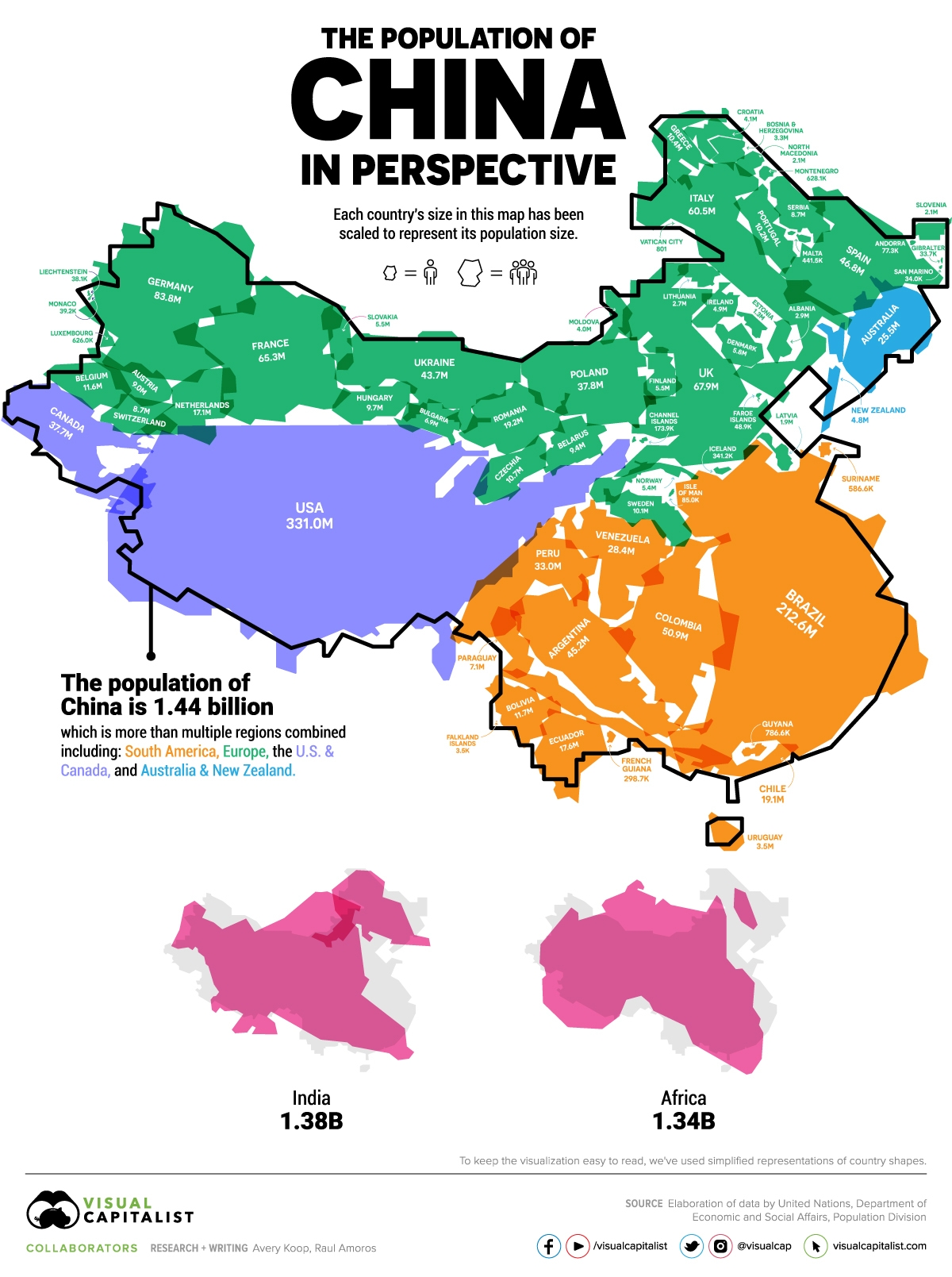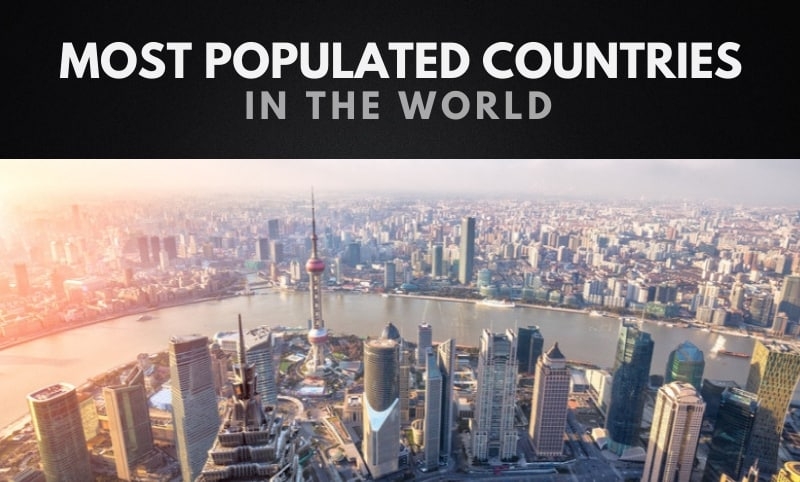How Many People Are There in China - Updated Population
 |
China population is 1,444,327,501 as of Thursday, May 27, 2021, based on Worldometer elaboration of the latest United Nations data.
China 2020 population is estimated at 1,439,323,776 people at mid-year according to UN data. China's population is equivalent to 18.47% of the total world population. China ranks number 1 in the list of countries (and dependencies) by population.
The population density in China is 153 per Km2 (397 people per mi2). The total land area is 9,388,211 Km2 (3,624,807 sq. miles). 60.8 % of the population is urban (875,075,919 people in 2020). The median age in China is 38.4 years.
 |
| Photo: Visual Capitalist |
Population of China (2020 and historical)
China is the world’s most populous country with an astounding 1.44 billion citizens. Altogether, the size of the population of China is larger than nearly four regions combined: South America, Europe (excluding Russia), the U.S. & Canada, and Australia & New Zealand.
Using data from the United Nations, this unconventional map reveals the comparative size of China’s population next to a multitude of other countries.
| Year | Population | Yearly % Change | Migrants (net) | Median Age | Fertility Rate | Density (P/Km²) | Country's Share of World Pop | China Global Rank |
|---|---|---|---|---|---|---|---|---|
| 2020 | 1,439,323,776 | 0.39 % | -348,399 | 38.4 | 1.69 | 153 | 18.47 % | 1 |
| 2019 | 1,433,783,686 | 0.43 % | -348,399 | 37.0 | 1.65 | 153 | 18.59 % | 1 |
| 2018 | 1,427,647,786 | 0.47 % | -348,399 | 37.0 | 1.65 | 152 | 18.71 % | 1 |
| 2017 | 1,421,021,791 | 0.49 % | -348,399 | 37.0 | 1.65 | 151 | 18.83 % | 1 |
| 2016 | 1,414,049,351 | 0.51 % | -348,399 | 37.0 | 1.65 | 151 | 18.94 % | 1 |
| 2015 | 1,406,847,870 | 0.55 % | -310,442 | 36.7 | 1.64 | 150 | 19.06 % | 1 |
| 2010 | 1,368,810,615 | 0.57 % | -435,677 | 35.0 | 1.62 | 146 | 19.68 % | 1 |
| 2005 | 1,330,776,380 | 0.62 % | -393,116 | 32.6 | 1.61 | 142 | 20.34 % | 1 |
| 2000 | 1,290,550,765 | 0.79 % | -76,600 | 30.0 | 1.62 | 137 | 21.01 % | 1 |
| 1995 | 1,240,920,535 | 1.07 % | -155,996 | 27.4 | 1.83 | 132 | 21.60 % | 1 |
| 1990 | 1,176,883,674 | 1.82 % | -86,330 | 24.9 | 2.73 | 125 | 22.09 % | 1 |
| 1985 | 1,075,589,361 | 1.47 % | -40,000 | 23.5 | 2.52 | 115 | 22.08 % | 1 |
| 1980 | 1,000,089,235 | 1.55 % | -9,401 | 21.9 | 3.01 | 107 | 22.43 % | 1 |
| 1975 | 926,240,885 | 2.28 % | -221,096 | 20.3 | 4.85 | 99 | 22.70 % | 1 |
| 1970 | 827,601,394 | 2.70 % | -32,000 | 19.3 | 6.30 | 88 | 22.36 % | 1 |
| 1965 | 724,218,968 | 1.86 % | -225,145 | 19.8 | 6.15 | 77 | 21.69 % | 1 |
| 1960 | 660,408,056 | 1.53 % | -11,900 | 21.3 | 5.48 | 70 | 21.76 % | 1 |
| 1955 | 612,241,554 | 2.00 % | -51,205 | 22.2 | 6.11 | 65 | 22.08 % | 1 |
Looking at history, the population of China has more than doubled since the 1950s. The country was the first in the world to hit one billion people in 1980, reported Visual Capitalist.
However, in 1979, in an attempt to control the burgeoning population, the infamous one-child policy was introduced, putting controls on how many children Chinese citizens could have.
While the government eventually recognized the negative implications of this policy, it appeared to be too little, too late. The two-child policy was introduced in 2016, but it has not yet reversed the current slowdown in population growth.
The fertility rate has been consistently falling from over 6 births per woman in 1955 to 1.69 in 2020. Today, the median age in China is 38 years old, rising from 22 in 1955. Longer life spans and fewer births form a demographic trend that has many social and economic implications.
Overall, China’s young population is becoming scarcer, meaning that the domestic labor market will eventually begin shrinking. Additionally, the larger share of elderly citizens will require publicly-funded resources, resulting in a heavier societal and financial burden.
China Population Forecast
| Year | Population | Yearly % Change | Migrants (net) | Median Age | Fertility Rate | Density (P/Km²) | Country's Share of World Pop | China Global Rank |
|---|---|---|---|---|---|---|---|---|
| 2020 | 1,439,323,776 | 0.46 % | -348,399 | 38.4 | 1.69 | 153 | 18.47 % | 1 |
| 2025 | 1,457,908,249 | 0.26 % | -371,264 | 40.2 | 1.69 | 155 | 17.81 % | 1 |
| 2030 | 1,464,340,159 | 0.09 % | -352,100 | 42.6 | 1.69 | 156 | 17.13 % | 2 |
| 2035 | 1,461,083,029 | -0.04 % | -311,798 | 45.0 | 1.69 | 156 | 16.44 % | 2 |
| 2040 | 1,449,031,423 | -0.17 % | -311,801 | 46.3 | 1.69 | 154 | 15.75 % | 2 |
| 2045 | 1,429,312,248 | -0.27 % | -311,081 | 47.2 | 1.69 | 152 | 15.07 % | 2 |
| 2050 | 1,402,405,170 | -0.38 % | -310,079 | 47.6 | 1.69 | 149 | 14.41 % | 2 |
Whether or not China’s population growth is slowing appears to be less relevant when looking at its sheer size. While India is expected to match the country’s population by 2026, China will remain one of the world’s largest economic powerhouses regardless.
It is estimated, however, that the population of China will drop below one billion people by the year 2100—bumping the nation to third place in the ranking of the world’s most populous countries. At the same time, it’s possible that China’s economic dominance may be challenged by these same demographic tailwinds as time moves forward.
READ MORE: Facts About the Countries in the World: How Many, Population, Oldest, Youngest, Richest
 How Many People Are There in the United States: Updated Population How Many People Are There in the United States: Updated Population The United States of America (USA) is the world's third-largest country in size and nearly the third largest in terms of population. Check out ... |
 How Many People Are There In The World: World Population Update & Analysis How Many People Are There In The World: World Population Update & Analysis How many people are living on Earth with us right now? How has the world population changed in recent years? Check out the answer below! |
 Top 9 Biggest Countries in the World by Population (Updated) Top 9 Biggest Countries in the World by Population (Updated) Below you will find the most up-to-date list of population figures by country. Check out Top 9 Biggest Countries in the World - Most ... |


























